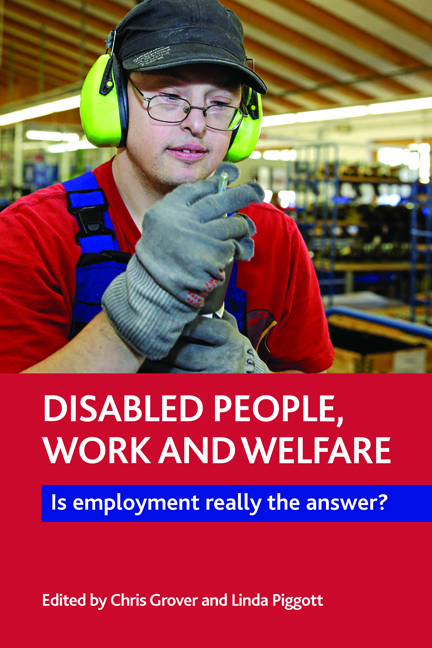Book contents
- Frontmatter
- Dedication
- Contents
- List of tables and figures
- List of abbreviations
- Notes on contributors
- Acknowledgements
- one Disabled people, work and welfare
- Part One Changing constructions of disability and welfare
- Part Two Social policy, work and disabled people
- Part Three Assistance and access to paid work
- Part Four Alternatives to, and validated lives beyond, paid work
- Part Five Conclusion
- Index
six - Disabled people and employment in Poland
Published online by Cambridge University Press: 11 March 2022
- Frontmatter
- Dedication
- Contents
- List of tables and figures
- List of abbreviations
- Notes on contributors
- Acknowledgements
- one Disabled people, work and welfare
- Part One Changing constructions of disability and welfare
- Part Two Social policy, work and disabled people
- Part Three Assistance and access to paid work
- Part Four Alternatives to, and validated lives beyond, paid work
- Part Five Conclusion
- Index
Summary
Introduction
The Republic of Poland is a Central European country with a population of 38.5 million people. It is estimated that between 12.2% and 21.5% of the Polish population can be considered as disabled. The lower figure comes from the last National Census carried out in 2011 (CSO, 2013a, p 24), which defines a disabled person as ‘a person who has an appropriate disability certificate or a person who does not have such a certificate but has a limited ability to perform basic activities for their age (play, learning, work, activities of daily living)’. The higher figure is derived from the 2009 European Health Interview Survey. It defines disability as ‘limitations in activities people usually do because of health problems for at least the past six months’ (CSO, 2011, p 70). It is estimated that almost half of those people who might be defined as disabled in Poland are of working age.
In this chapter, the employment position of disabled people in Poland is discussed. The prevailing view in Poland is that it is desirable for disabled people to work. However, as we shall see, it is the case that disabled people there are more likely to not be working than they are to be working. This chapter examines policies in Poland that are supposed to help disabled people access paid employment and critically engages with them. The chapter is divided into three main sections. The first section focuses on the legal status of disabled people in Poland, in particular the way a right to work for disabled people has been construed in Poland. This section examines employment policies before and after the collapse of Communism in 1989 in Poland and discusses the effectiveness of the Polish quota-levy system. It also examines supply-side policies used to address the low level of employment among disabled people. The second section examines the social security system for disabled people in Poland. The third section examines employment opportunities in the open and sheltered labour markets and discusses disabled people's experiences of paid work.
Disability and paid work
While Poland does not have comprehensive disability rights law, the rights of disabled people are protected by various international and domestic Acts. There was an attempt to create a universal Act that would concern most of the areas of disabled people's lives (it was to be entitled the Act on Equal Opportunities of Persons with Disabilities).
- Type
- Chapter
- Information
- Disabled People, Work and WelfareIs Employment Really the Answer?, pp. 105 - 126Publisher: Bristol University PressPrint publication year: 2015

